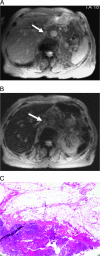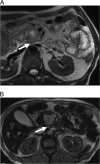Accurate prediction of nodal status in preoperative patients with pancreatic ductal adenocarcinoma using next-gen nanoparticle
- PMID: 24466369
- PMCID: PMC3890701
- DOI: 10.1593/tlo.13400
Accurate prediction of nodal status in preoperative patients with pancreatic ductal adenocarcinoma using next-gen nanoparticle
Abstract
Objective: The objective of this study is to assess lymphotropic nanoparticle-enhanced magnetic resonance imaging (LNMRI) in identifying malignant nodal involvement in patients with pancreatic ductal adenocarcinoma.
Methods: Magnetic resonance imaging was performed in 13 patients with known or high index of suspicion of pancreatic cancer and who were scheduled for surgical resection. Protocols included T2*-weighted imaging before and after administration of Ferumoxytol (Feraheme) for the evaluation of lymph node involvement. Eleven of the 13 patients underwent a Whipple procedure and lymph node dissection. Nodes that lacked contrast uptake were deemed malignant, and those that demonstrated homogeneous uptake were deemed benign.
Results: A total of 264 lymph nodes were resection, of which 17 were malignant. The sensitivity and specificity of LNMRI was 76.5% and 98.4% at a nodal level and 83.3% and 80% at a patient level.
Conclusion: LNMRI demonstrated high sensitivity and specificity in patients with pancreatic ductal adenocarcinoma.
Figures





Similar articles
-
Pilot study evaluating use of lymphotrophic nanoparticle-enhanced magnetic resonance imaging for assessing lymph nodes in renal cell cancer.Urology. 2008 Apr;71(4):708-12. doi: 10.1016/j.urology.2007.11.096. Epub 2008 Mar 4. Urology. 2008. PMID: 18295316 Clinical Trial.
-
Comparison of lymphotropic nanoparticle-enhanced MRI sequences in patients with various primary cancers.AJR Am J Roentgenol. 2006 Dec;187(6):W582-8. doi: 10.2214/AJR.05.0873. AJR Am J Roentgenol. 2006. PMID: 17114509 Clinical Trial.
-
Lymphotropic nanoparticle-enhanced MRI for independent prediction of lymph node malignancy: a logistic regression model.AJR Am J Roentgenol. 2009 Sep;193(3):W230-7. doi: 10.2214/AJR.08.2175. AJR Am J Roentgenol. 2009. PMID: 19696264
-
Lymphotropic nanoparticle enhanced MR imaging (LNMRI) technique for lymph node imaging.Eur J Radiol. 2006 Jun;58(3):367-74. doi: 10.1016/j.ejrad.2005.12.041. Epub 2006 Feb 10. Eur J Radiol. 2006. PMID: 16472955 Review.
-
Lymphotrophic nanoparticle enhanced MR imaging (LNMRI) for lymph node imaging.Abdom Imaging. 2006 Nov-Dec;31(6):660-7. doi: 10.1007/s00261-006-9006-2. Abdom Imaging. 2006. PMID: 16680506 Review.
Cited by
-
Safety and feasibility of near-infrared image-guided lymphatic mapping of regional lymph nodes in esophageal cancer.J Thorac Cardiovasc Surg. 2016 Aug;152(2):546-54. doi: 10.1016/j.jtcvs.2016.04.025. Epub 2016 Apr 11. J Thorac Cardiovasc Surg. 2016. PMID: 27179838 Free PMC article. Clinical Trial.
-
Prediction of Anti-cancer Nanotherapy Efficacy by Imaging.Nanotheranostics. 2017 Jul 6;1(3):296-312. doi: 10.7150/ntno.20564. eCollection 2017. Nanotheranostics. 2017. PMID: 29071194 Free PMC article. Review.
-
Positive para-aortic lymph nodes following pancreatectomy for pancreatic cancer. Systematic review and meta-analysis of impact on short term survival and association with clinicopathologic features.HPB (Oxford). 2016 Aug;18(8):633-41. doi: 10.1016/j.hpb.2016.04.007. Epub 2016 Jun 3. HPB (Oxford). 2016. PMID: 27485057 Free PMC article.
-
Repurposing ferumoxytol: Diagnostic and therapeutic applications of an FDA-approved nanoparticle.Theranostics. 2022 Jan 1;12(2):796-816. doi: 10.7150/thno.67375. eCollection 2022. Theranostics. 2022. PMID: 34976214 Free PMC article. Review.
-
Ultrasmall superparamagnetic iron oxide nanoparticle uptake as noninvasive marker of aortic wall inflammation on MRI: proof of concept study.Br J Radiol. 2018 Dec;91(1092):20180461. doi: 10.1259/bjr.20180461. Epub 2018 Sep 12. Br J Radiol. 2018. PMID: 30160173 Free PMC article.
References
-
- Siegel R, Naishadham D, Jemal A. Cancer statistics, 2013. CA Cancer J Clin. 2013;63(1):11–30. - PubMed
-
- Yachida S. Novel therapeutic approaches in pancreatic cancer based on genomic alterations. Curr Pharm Des. 2012;18(17):2452–2463. - PubMed
-
- Cinar P,, Tempero MA. Monoclonal antibodies and other targeted therapies for pancreatic cancer. Cancer J. 2012;18(6):653–664. - PubMed
-
- Abelson JA, Murphy JD, Minn AY, Chung M, Fisher GA, Ford JM, Kunz P, Norton JA, Visser BC, Poultsides GA, et al. Intensity-modulated radiotherapy for pancreatic adenocarcinoma. Int J Radiat Oncol Biol Phys. 2012;82(4):e595–e601. - PubMed
LinkOut - more resources
Full Text Sources
Other Literature Sources
